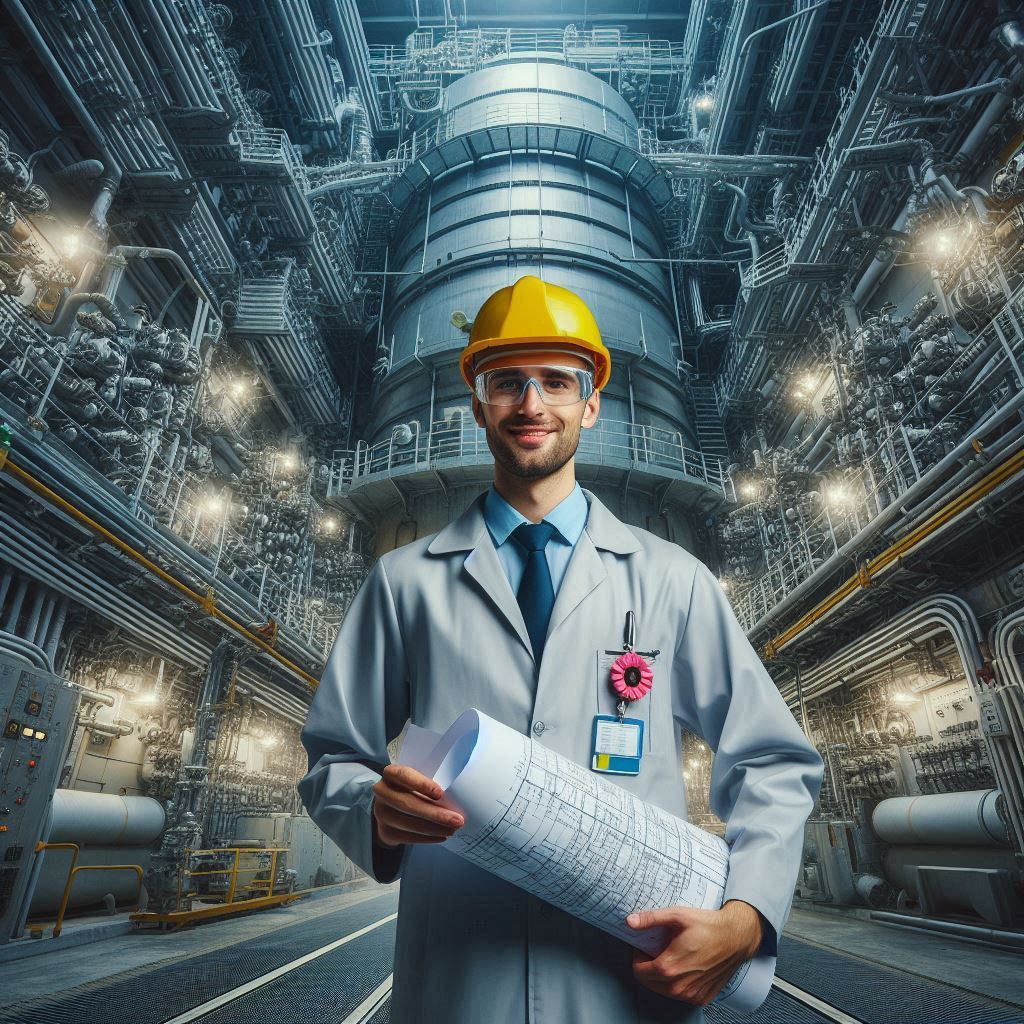Introduction
Introduce the Topic of Nuclear Engineers and Fusion Energy
Nuclear engineers are vital in the pursuit of fusion energy, a groundbreaking technology with the potential to transform power generation.
Fusion energy replicates the sun‘s natural processes, offering a nearly infinite and clean energy source.
This technology represents a significant leap forward from conventional energy sources, promising both sustainability and efficiency.
The Importance of Nuclear Engineers in Advancing Fusion Energy Technology
Nuclear engineers are at the forefront of making fusion energy a reality.
They tackle complex challenges in reactor design, material science, and plasma confinement.
Their expertise drives innovation and addresses the technical hurdles that stand in the way of practical fusion power.
By developing advanced reactor concepts and refining plasma control methods, they push the boundaries of current technology.
Their contributions are crucial for moving fusion energy from theoretical concepts to practical applications, paving the way for a future with cleaner, more sustainable energy.
The role of nuclear engineers in developing fusion energy
The Specific Responsibilities and Tasks of Nuclear Engineers in the Field of Fusion Energy
Nuclear engineers hold vital responsibilities in advancing fusion energy.
They design and develop reactors capable of sustaining fusion reactions.
This involves creating and maintaining conditions of extreme temperature and pressure.
Engineers also work on plasma confinement systems using magnetic fields.
They design these systems to control and contain the hot, electrically charged plasma where fusion occurs.
Testing and refining these systems are essential for ensuring reactor safety and efficiency.
Additionally, engineers develop methods for extracting and converting fusion energy into electricity.
They must address energy capture and conversion challenges while ensuring reliability and economic feasibility.
Collaboration with physicists and material scientists is also a key task.
Engineers integrate diverse expertise to tackle complex problems and scale experimental reactors to practical power plants.
The Skills and Expertise Required for Nuclear Engineers to Work on Fusion Energy Projects
To work on fusion energy projects, nuclear engineers need a diverse skill set and specialized knowledge.
Advanced degrees in nuclear engineering, physics, or materials science are often required.
Expertise in plasma physics is crucial for understanding and controlling fusion reactions.
Engineers must also be adept in designing and implementing magnetic confinement systems.
Skills in materials science are necessary to develop materials that can withstand extreme conditions.
Strong problem-solving abilities are essential for addressing complex engineering challenges.
Engineers should also be proficient in simulation and modeling techniques to predict reactor behavior.
Collaboration skills are important for working effectively with multidisciplinary teams.
Continuous learning and staying updated with the latest research and technological advancements are also vital.
This ongoing education ensures engineers can handle emerging challenges and leverage new opportunities in fusion energy.
Read: The Role of Aerospace Engineers in Satellite Development
Advances in fusion energy technology
Recent Developments in Fusion Energy Technology
Recent developments in fusion energy technology have propelled the field closer to practical implementation.
Advances include the ITER project in France, a major tokamak reactor designed to sustain fusion reactions.
This project aims to achieve a net energy gain from fusion.
Additionally, private companies are exploring alternative reactor designs, such as stellarators and inertial confinement systems.
These innovations focus on improving the stability and efficiency of fusion reactions.
Progress in high-temperature superconductors has also been notable.
These materials are crucial for generating the powerful magnetic fields needed to confine plasma.
Enhanced computational models now provide more accurate predictions of reactor performance, contributing to better reactor designs.
Advances in material science have led to the development of components that can endure the extreme conditions within fusion reactors, addressing long-standing engineering challenges.
How Nuclear Engineers Have Contributed to These Advancements
Nuclear engineers have played a key role in these advancements.
They design and develop fusion reactors, including tokamaks and stellarators, ensuring they operate effectively and safely.
Engineers work on creating advanced magnetic confinement systems to control plasma, making fusion reactions more stable and efficient.
Their contributions extend to the development of high-temperature superconductors, which are essential for generating strong magnetic fields.
Engineers also focus on improving reactor materials, developing components that can withstand the extreme conditions inside reactors.
By enhancing computational models, they provide more accurate predictions of reactor behavior, which helps refine reactor designs.
Collaboration with physicists and other experts enables engineers to integrate new technologies and approaches effectively.
Their work ensures that innovations in fusion energy technology move from experimental stages to practical applications, driving progress towards a sustainable energy future.
Read: Aerospace Engineering in Commercial Spaceflight
Challenges Faced by Nuclear Engineers in the Development of Fusion Energy
Nuclear engineers face several challenges in developing fusion energy technology.
One major obstacle is achieving and maintaining the extreme conditions necessary for fusion.
Fusion reactions require temperatures exceeding 100 million degrees Celsius, far hotter than the core of the sun.
Containing this superheated plasma is another challenge; it must be held in place without touching reactor walls.
Another significant challenge is developing materials that can endure intense heat and radiation.
These materials must resist degradation over time to ensure reactor longevity.
Additionally, engineers must address the complexity of designing and operating large-scale fusion reactors, which involves sophisticated control systems and precision engineering.
The Obstacles and Difficulties That Nuclear Engineers Encounter in Their Work on Fusion Energy Projects
Nuclear engineers encounter several specific obstacles in fusion energy projects.
One major difficulty is creating and maintaining stable plasma conditions.
The plasma must be controlled precisely, requiring advanced magnetic confinement systems.
Engineers also face challenges in developing materials that can withstand the harsh environment inside the reactor, including high temperatures and neutron flux.
Scalability is another issue; transitioning from small experimental reactors to full-scale commercial power plants presents numerous technical and economic hurdles.
Ensuring that fusion reactors can produce more energy than they consume remains a significant challenge.
Engineers must also address safety concerns related to the high-energy processes involved.
How Nuclear Engineers Overcome These Challenges Through Innovation and Problem-Solving
Nuclear engineers tackle these challenges through innovative approaches and problem-solving.
To maintain stable plasma, they develop advanced magnetic confinement techniques, such as improved tokamak designs and alternative confinement methods.
Engineers are working on high-temperature superconductors to create stronger magnetic fields that better control plasma.
In materials science, engineers are researching and developing new materials that can withstand extreme conditions.
This includes testing various alloys and composites to find those with the best performance.
Engineers also use advanced simulation tools to model reactor behavior and predict potential issues before they arise.
Addressing scalability, engineers work on designing modular reactor components that can be more easily scaled up from experimental to commercial sizes.
They also focus on improving the efficiency of energy production and developing cost-effective solutions.
Collaboration with other scientists and engineers fosters the sharing of knowledge and accelerates problem-solving.
Through these innovations, nuclear engineers continue to make significant strides in overcoming the challenges of fusion energy technology, bringing us closer to a viable and sustainable energy source.
Read: Biomedical Engineering: Impact on Public Health

See Related Content: How to Balance Work and Life as a Biomedical Technician
Benefits of Fusion Energy
Fusion energy offers several significant advantages over traditional energy sources.
First and foremost, fusion provides a nearly limitless energy supply.
The fuel for fusion reactions, typically isotopes of hydrogen such as deuterium and tritium, is abundantly available from water and lithium.
Unlike fossil fuels, fusion reactions produce minimal waste and no greenhouse gases.
Fusion energy also boasts a high energy density.
A small amount of fusion fuel can produce a vast amount of energy, far exceeding the energy output of conventional fuels.
This efficiency translates into a smaller environmental footprint for energy production.
Moreover, fusion reactions do not carry the risk of catastrophic accidents, unlike fission reactors, which can suffer from meltdowns.
The Advantages of Fusion Energy Compared to Traditional Energy Sources
- Abundant Fuel Supply: Fusion uses hydrogen isotopes, which are widely available from water and lithium sources.
- Low Environmental Impact: Fusion produces no greenhouse gases and minimal radioactive waste, reducing pollution and mitigating climate change.
- High Energy Density: Fusion reactions generate large amounts of energy from small amounts of fuel, enhancing efficiency.
- Safety: Fusion reactions are inherently safe, with no risk of runaway reactions or meltdowns.
- Reduced Radioactive Waste: The waste produced is short-lived compared to the long-lived waste from fission reactors.
How Fusion Energy Can Help Address Environmental Concerns and Contribute to Sustainable Energy Production
Fusion energy addresses environmental concerns in several key ways.
First, by producing no greenhouse gases, fusion helps combat climate change.
It eliminates the need for burning fossil fuels, which is a major source of carbon emissions.
The minimal waste generated by fusion is less harmful than the long-lived radioactive waste from fission reactors.
Fusion energy also contributes to sustainable energy production by providing a reliable and virtually inexhaustible source of power.
The abundance of fusion fuel means that energy production can continue without depleting natural resources.
Additionally, fusion reactors do not have the same environmental risks associated with fossil fuel extraction and processing.
By integrating fusion energy into the global energy mix, we can reduce reliance on carbon-intensive energy sources and transition towards a more sustainable and environmentally friendly energy system.
This shift is crucial for addressing the pressing challenges of climate change and ensuring a stable energy future.
Read: The Impact of Aerospace Engineering on Modern Life
Future Prospects for Fusion Energy
Fusion energy holds transformative potential for the future of the energy sector and society at large.
As technology advances, fusion could provide a nearly limitless, clean energy source, revolutionizing how we generate power.
The successful implementation of fusion reactors would significantly reduce reliance on fossil fuels, mitigating climate change and reducing environmental pollution.
In the long term, fusion energy could lead to a more stable and secure energy supply.
Unlike fossil fuels, fusion does not face issues of resource depletion or geopolitical conflicts over energy resources.
This stability could result in more predictable energy prices and enhanced energy security.
The Potential Impact of Fusion Energy on the Energy Sector and Society as a Whole
Fusion energy could profoundly impact the energy sector by diversifying the energy mix with a reliable, clean power source.
It would reduce dependence on fossil fuels, helping to lower greenhouse gas emissions and combat climate change.
The shift to fusion energy would also reduce the environmental damage associated with mining and burning fossil fuels.
Societally, fusion energy could lead to more affordable and accessible electricity.
As fusion reactors become commercially viable, they could provide a stable energy supply that supports economic growth and development.
Improved energy access could enhance quality of life, especially in regions that currently face energy scarcity.
Opportunities for Nuclear Engineers to Continue Pushing the Boundaries of Fusion Energy Technology
Nuclear engineers have numerous opportunities to advance fusion energy technology further.
They can explore innovative reactor designs, such as next-generation tokamaks and stellarators, to improve efficiency and performance.
Engineers can also work on developing advanced materials capable of withstanding the extreme conditions inside fusion reactors.
Another area of opportunity is the advancement of plasma confinement techniques.
Engineers can focus on refining magnetic confinement systems and exploring alternative confinement methods to achieve better plasma stability.
Additionally, engineers can contribute to the development of new energy extraction technologies, enhancing the efficiency of converting fusion energy into electricity.
Collaboration with international research teams and private sector initiatives offers avenues for engineers to contribute to large-scale fusion projects.
As fusion technology evolves, continuous research and innovation will be key to overcoming remaining challenges and realizing the full potential of fusion energy.
By pushing the boundaries of fusion technology, nuclear engineers play a crucial role in shaping a future where clean, sustainable energy is a reality.
Their ongoing efforts will drive progress and help address global energy and environmental challenges.
Conclusion
The Key Points Discussed in the Blog Post
Nuclear engineers are key players in advancing fusion energy technology.
They tackle intricate challenges that hinder the practical use of fusion power.
Their work encompasses developing advanced reactor designs and improving plasma confinement techniques.
These efforts bring fusion energy closer to reality by addressing critical technical issues.
Their innovations in materials and reactor technology push the boundaries of what‘s achievable, aiming for a cleaner and more sustainable energy future.
Transform Your Career Today
Unlock a personalized career strategy that drives real results. Get tailored advice and a roadmap designed just for you.
Start NowThe Role of Nuclear Engineers in Driving Innovation and Progress in the Field of Fusion Energy
Nuclear engineers are crucial in the drive toward practical fusion energy.
They are at the forefront of overcoming complex scientific and engineering hurdles.
By refining plasma confinement methods and reactor designs, they lead the way in technological advancements.
Their dedication accelerates progress and brings us nearer to a viable fusion energy source.
Their work not only promises a significant reduction in environmental impact but also enhances energy security.
As the field evolves, nuclear engineers will continue to play an essential role in making fusion energy a reality, transforming the future of power generation.
[E-Books for Sale]
The Big Book of 500 High-Paying Jobs in America: Unlock Your Earning Potential
$19.99 • 500 High-Paying Jobs • 330 pages
Explore 500 high-paying jobs in America and learn how to boost your career, earn more, and achieve success!
See All 500 High-Paying Jobs of this E-Book
1001 Professions Without a Degree: High-Paying American Jobs You Can Start Now
$19.99 • 1001 Professions Without a Degree • 174 pages
Discover 1001 high-paying jobs without a degree! Unlock career tips, skills, and success strategies for just $19.99!




